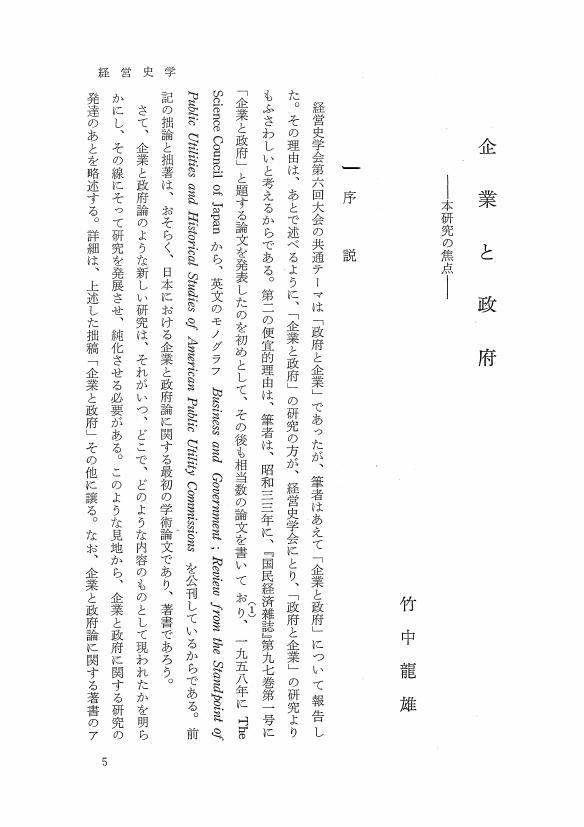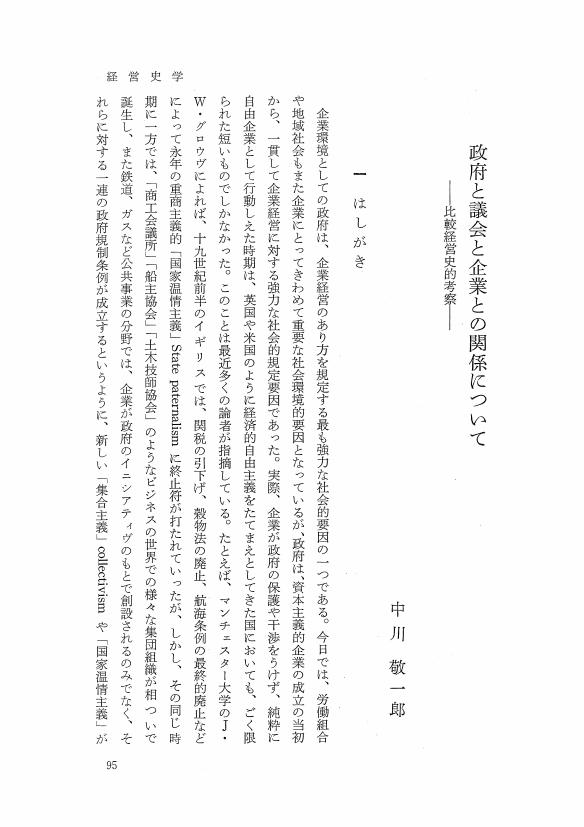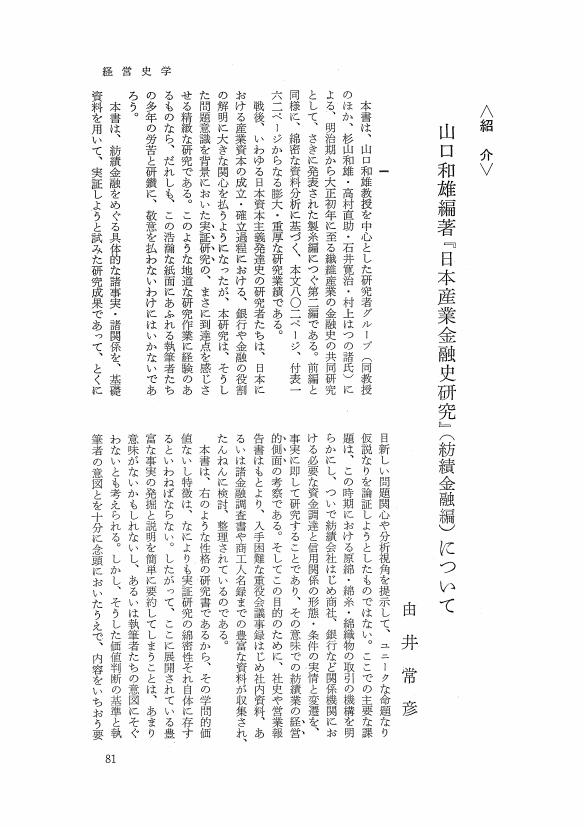1 0 0 0 OA 政府と企業 問題提起
- 著者
- 角山 栄
- 出版者
- 経営史学会
- 雑誌
- 経営史学 (ISSN:03869113)
- 巻号頁・発行日
- vol.6, no.1, pp.1-4, 1971-10-20 (Released:2009-10-14)
The Sixth Annual Conference of the Japan Business History Society was held on 28-30th October, 1970, at the Murobe-Inn, Shirahama Spa, Wakayamaken. It was organized successfully by Prof. S. Tsunoyama as the first boarding conference of our society.In openning the conference, Prof. Tsunoyama emphasized that the close relationship between government and business in every country, particularly notable after the Second World War, has its origin in the early stage of industrialization and the economic functions of modern government should be considered historically according to the following four categories : government as (1) regulator, (2) promoter, (3) entrepreneur, and (4) planner.The first speaker, Prof. Tatsuo Takenaka (Kônan University), having emphasized the difference of meaning between “government and business” and “business and government”, reviewed from the latter point of view the studies on the public utilities in U.S.A. over the last several decades.The second speaker, Prof. Sadao Takadera (Kyoto University) analysed the policies of the early Meiji government to promote business activities by the introduction of the western system of depreciation into government-aided enterprises in banking and shipping.On the second day three papers were read ; two in the morning, and one in the evening.The first speaker, Prof. Takeshi Fukuo (Tokyo College of Economics) pointed out that Prussian Beamtenunternehmer in the first half of the nineteenth century played a conspicuous role to promote German industrialization, performing as an entrepreneur of state enterprises and in the latter half of the nineteenth century the government functioned rather as a promoter of the private enterprises so that the latter might be able to compete with those in the advanced countries.In Japan the government policy in 1880's of selling out government owned enterprises to private entrepreneurs could successfully encourage the rapid industrialization. Prof. Masaaki Kobayashi (Kanto-gakuin University) elaborated the major objectives of the government leaders in their policy of selling-out.The evening lecture was delivered by Prof. Keiichiro Nakagawa (Tokyo University). He compared and contracted the relationships between government, parliament and business in Japan with those in U. S. A. and Britain. Prof. Yoshitaro Wakimura (Tokyo University) commented on the activities of the government officials in Japan and America in the pre-war period.At the third day meeting two papers were read on the Japanese government policies in relation to the transportation. Prof. Tadashi Uda (Ottemon-gakuin College) analysed the government “railway strategy” for constructing and administering the national and private railways.Lastly, Prof. Hiroshi Okaniwa (Osaka College of Trade) criticized the government shipping policies. He pointed out that the practical measures taken by the Japanese government were to aid some particular big shipping companies, not to aid private shipping business in general.
1 0 0 0 OA 企業と政府 本研究の焦点
- 著者
- 竹中 龍雄
- 出版者
- 経営史学会
- 雑誌
- 経営史学 (ISSN:03869113)
- 巻号頁・発行日
- vol.6, no.1, pp.5-16, 1971-10-20 (Released:2009-10-14)
1 0 0 0 OA 討論1
- 出版者
- 経営史学会
- 雑誌
- 経営史学 (ISSN:03869113)
- 巻号頁・発行日
- vol.6, no.1, pp.15-17, 1971-10-20 (Released:2009-10-14)
1 0 0 0 OA 明治減価償却史上の政府と企業
- 著者
- 高寺 貞男
- 出版者
- 経営史学会
- 雑誌
- 経営史学 (ISSN:03869113)
- 巻号頁・発行日
- vol.6, no.1, pp.18-35, 1971-10-20 (Released:2009-10-14)
1 0 0 0 OA 討論2
- 出版者
- 経営史学会
- 雑誌
- 経営史学 (ISSN:03869113)
- 巻号頁・発行日
- vol.6, no.1, pp.35-36, 1971-10-20 (Released:2009-10-14)
1 0 0 0 OA 討論3
- 出版者
- 経営史学会
- 雑誌
- 経営史学 (ISSN:03869113)
- 巻号頁・発行日
- vol.6, no.1, pp.67-68, 1971-10-20 (Released:2009-10-14)
1 0 0 0 OA 討論4
- 出版者
- 経営史学会
- 雑誌
- 経営史学 (ISSN:03869113)
- 巻号頁・発行日
- vol.6, no.1, pp.91-94, 1971-10-20 (Released:2009-10-14)
1 0 0 0 OA 政府と議会と企業との関係について 比較経営史的考察
- 著者
- 中川 敬一郎
- 出版者
- 経営史学会
- 雑誌
- 経営史学 (ISSN:03869113)
- 巻号頁・発行日
- vol.6, no.1, pp.95-118, 1971-10-20 (Released:2009-10-14)
- 参考文献数
- 8
1 0 0 0 OA 経営史からみた技術類型と企業者の技術選択
- 著者
- 大河内 暁男
- 出版者
- 経営史学会
- 雑誌
- 経営史学 (ISSN:03869113)
- 巻号頁・発行日
- vol.5, no.2, pp.1-21,i, 1971-03-25 (Released:2010-11-18)
Technology in business enterprise is defined as the way of doing daily work; then, the definition of technical progress in business enterprise should be the change in the way of doing work; change here means the creation of a new way of doing work and the exploitation of new horizons in business activities. From this view point of “change in the way”, technology in business enterprise could, according to a) whether it implies the change or not, b) what is the character of the way of change, be classified into the following four traits, or classes. 1) Basic innovative technology, based mainly on scientific research, exploiting and providing a new technical sphere, for example, the discovery of penicillin and invention of a method of extracting it, which opened the world of antibiotic, 2) Applied technology, which develop the various potential possibilities in the technical sphere exploited by basic innovative technology, 3) Imitative technology, 4) Conventional unchanging technology, which refuses to be changed or fails to recognize the necessity of changing the way.For the growth of business enterprise, basic innovative technology has the most promising perspectives, protected by patent right, both domestic and international, though it is accompanied by the greatest risk.With applied technology, a business enterprise could have great success, sometimes greater than the achievement of “basic innovative technology” enterprise. This success is, however, limited only within the sphere defined by the basic innovative technology.Which class of technology should be used in a certain business enterprise is the problem of entrepreneurial choice, decided by the entrepreneur's perception of technology.
1 0 0 0 OA アメリカ的労務管理の一側面 -労務管理と先任権制度-
- 著者
- 大東 英祐
- 出版者
- 経営史学会
- 雑誌
- 経営史学 (ISSN:03869113)
- 巻号頁・発行日
- vol.5, no.2, pp.47-71,ii, 1971-03-25 (Released:2010-11-18)
It is generally believed that American workers move much more freely than Japanese employees. But relatively little attention has been paid to the fact that the rate of turnover in the period of World War I was reduced to one-third in the 1950's.For the main reason why the rate of turnover has become lower, we can point out the fact that the seniority system has spread throughout the industries in America since the 1930's. In those days, seniority, though the debate about seniority and management prerogatives in furious, governs not only lay-off and re-call but also promotion, transfer, paid holidays, and many other fringe-benefits.Under these circumstances, the problem of the gain accompanied with long service and the loss accused by the employment change is important. Therefore, it is no wonder that American workers no longer quit so freely as before.Historically, seniority was not the management but union policy. The Management, however, seemed to have good grounds for accepting the unions' demands and we can attribute the rapid diffusion of seniority to the following two factors.First, according to several studies, work organization, with the growth of mass-production, had been formed as a promotion ladder by the 1930's, and it had been a rather common practice to fill a job vacancy, not with the one from outside, but by promotion within the firm.As a result, in the absence of unions, the order of lay-off by and large, comformed to the seniority principle.Second, the principle of seniority, as Reader pointed out, is consistent with the American sense of fairness, ie, the first come, first served.But in pre-union days, much was done through the foreman's personal favoritism without centralized policy, and so intra-firm wage structure was often in a chaotic condition. Confronted with union demand, the management in the 1930's tried to systematize its practice. Personnel departments were expanded and job analysis and evaluation plans were executed and so on. By these efforts the present personnel management system was to be established.
1 0 0 0 OA 文化的価値と工業化の論理
- 著者
- ヨハネス ヒルシュマイヤー
- 出版者
- 経営史学会
- 雑誌
- 経営史学 (ISSN:03869113)
- 巻号頁・発行日
- vol.5, no.3, pp.1-33, 1971-08-25 (Released:2010-11-18)
It has by now become accepted theory that success or failure as well as the particular course of the industrialization process is strongly influenced by cultural values. But often enough the problem is simplified by stressing the need to replace “traditional” (native) values with “rational” (Western) ones, implying that only the Western type mentality is capable of becoming the carrier of the industrialization process. I take the position that within the constraints of economic and technical conditions, very different value patterns which are “traditional” to that country, can become successful bases for industrialization and modernization. This means of course that the same technological conditions can and do permit different economic behavior patterns. I establish this point by comparing both the values and the behavior patterns of Japan and the west in the pre-industrial and the industrial stage.As basic cultural values I take for the West the well-known Primacy of Reason and Supremacy of the Individual over the group. For Japan I take very opposite, the Primacy of Harmony and the Supremacy of the Group over the individual. I indicate how these divergent cultural values could develop and how they manifest themselves. The impact of these principles upon economic behavior prior to and during the seccessful industrialization periods is shown in some detail, using rather well-known material from economic and management history. Specifically, three aspects of economic behavior are studied, each of them logically necessary for industrialization : (a) The process of innovation and destruction ; (b) the process of competition ; (c) the goal-setting. I try to show that in each of these three aspects of economic change, there was a marked difference in approach between the West and Japan, and that this difference can clearly be reduced to the prevalence of the respective cultural values.While maintaining the strong persistence of traditional values during, and their positive contribution for the success of the industrialization process, I also agree that technology itself is constantly, albeit gradually, reshaping those values in both the West and Japan, and that the two are moving gradually closer together.
1 0 0 0 OA アメリカ農業機械工業におけるレイオフ制 マッコーミック収穫機会社の事例
- 著者
- 小林 袈裟治
- 出版者
- 経営史学会
- 雑誌
- 経営史学 (ISSN:03869113)
- 巻号頁・発行日
- vol.5, no.3, pp.34-50, 1971-08-25 (Released:2010-11-18)
The pay roll books of the McCormick works in Chicago show us the fact that, through the later part of the nineteenth century, the production of the reaping machine has been done with a kind of seasonal rhythm reached the peak in June. The peak was then followed by the sharp decline in employment which was practiced through a layoff, especilly, of the unskilled workers.Although this came from the historical fact that the reaper production was linked with the harvest season of the crops such as winter wheat, a layoff was, eventually, institutionalized in the industry.This paper intends to throw some lights on the labor management and examine the entrepreneurial significance of the layoff system on the growth of the enterprise.
1 0 0 0 OA 二〇世紀初期のアメリカ財務論 ウィリアム・H・ラフの所説とその背景をめぐって
- 著者
- 正木 久司
- 出版者
- 経営史学会
- 雑誌
- 経営史学 (ISSN:03869113)
- 巻号頁・発行日
- vol.5, no.3, pp.51-80, 1971-08-25 (Released:2010-11-18)
R. L. Nelson and S. R. Reid pointed out that the first wave of the major merger movementes in the United States occurred at the turn of the century. This first wave, so-called “Trust Movement”, resulted in a high degree of concentration and corporationism in many industries, and through the movement, business finance in Amirica became gradually systematized.W. H. Lough was a pioneer in the field of business finace at that time and made a great contribution to its systematization. Lough's theory, which was developed in his two books, Corporation Finance (1909) and Business Finance (1917), dealt, first, with the raising of initial capital needed for business enterprise, together with its proper apportionment for plant, equipment, and working capital second, with the accurate determination of profits and reserves, and the enlargement of capital permanently invested.A matter of primary concern for me was how his essential assertions mentioned above was developed in the changing economic conditions of those days. After summarizing Lough's theory, I examined the effectiveness of his method by some case studies.
1 0 0 0 OA 山口和雄編著『日本産業金融史研究』(紡績金融編)について
- 著者
- 由井 常彦
- 出版者
- 経営史学会
- 雑誌
- 経営史学 (ISSN:03869113)
- 巻号頁・発行日
- vol.5, no.3, pp.81-86, 1971-08-25 (Released:2010-11-18)
1 0 0 0 OA 日本における経営管理の特質-その歴史的考察- 問題提起
- 著者
- 山本 安次郎
- 出版者
- 経営史学会
- 雑誌
- 経営史学 (ISSN:03869113)
- 巻号頁・発行日
- vol.5, no.1, pp.1-14, 1970-10-25 (Released:2009-11-06)
All of the five articles in this special issue were read at the fifth annual meeting of the Business History Society of Japan which was held at the Nanzan University on November 8 and 9, 1969.In the opening address, Yamamoto explained why the fifth annual meeting had chosen the Characteristics of Business Management in Japan as its central subject, looking back to the central subjects from the first to the fourth meetings. He emphasized the influence of business management upon the economic growth and then introduced Chandler's and Farmer-Richman's theories which view the management as the most important dynamic force of economic development, and lastly pointed out three problems to be answered about the central subject : (1) How should the management functions in rapid economic growth in Japan be understood ? (2) What are the characteristics of Japanese business management ? and (3) Through what processes have they been formed historically ? Following Yamamoto's introduction, four papers were read.The first paper by Sugiyama of the Seikei University tried to clarify Japanese characteristics of business management through the comparison and analysis of the financial management of the cotton-spinning companies in the pre-War period.The second speaker, Yoshida of Keio Ueiversity, explored the central subject by explaining the history of production management in the electric manufacturing industries.The third speaker, Hazama of Tokyo University of Education, approached the subject by investigating the Japanese paternalistic style of labor management during the World War I period.The fourth and last speaker, Noda of Seikei University, compared the management philosophy of Mitsubishi with that of Mitsui and discussed Japanese characteristics of management organization.After these reports, a panel discussion on the above subject was held, and Sakai of the Nanzan University and Yamamoto presided over this symposium.
1 0 0 0 OA 戦前、紡績企業の財務活動
- 著者
- 杉山 和雄
- 出版者
- 経営史学会
- 雑誌
- 経営史学 (ISSN:03869113)
- 巻号頁・発行日
- vol.5, no.1, pp.15-36, 1970-10-25 (Released:2009-11-06)
1 0 0 0 OA コメント1
- 著者
- 下川 浩一
- 出版者
- 経営史学会
- 雑誌
- 経営史学 (ISSN:03869113)
- 巻号頁・発行日
- vol.5, no.1, pp.36-40, 1970-10-25 (Released:2009-11-06)
1 0 0 0 OA 生産管理の経営史 戦前の重電機生産を中心に
- 著者
- 吉田 正樹
- 出版者
- 経営史学会
- 雑誌
- 経営史学 (ISSN:03869113)
- 巻号頁・発行日
- vol.5, no.1, pp.41-67, 1970-10-25 (Released:2009-11-06)
1 0 0 0 OA コメント2
- 著者
- 土屋 守章
- 出版者
- 経営史学会
- 雑誌
- 経営史学 (ISSN:03869113)
- 巻号頁・発行日
- vol.5, no.1, pp.68-72, 1970-10-25 (Released:2009-11-06)












